![]()
![]()
![]()
Use LEFT and RIGHT arrow keys to navigate between flashcards;
Use UP and DOWN arrow keys to flip the card;
H to show hint;
A reads text to speech;
37 Cards in this Set
- Front
- Back
|
What is meant by the term “paradigm”?
|
A set of assumptions, concepts, values, and practices that constitutes a way of viewing reality for the community that shares them.
|
|
|
What is meant by the phrase “paradigm shift”?
|
A Paradigm shift can be described as a fundamental change in an individual's or a society's view of how things work in the world.
|
|
|
What is the basis behind the Rational Choice Theory?
|
The Rational Choice Paradigm is a theory based on the idea that all humans base their decisions on rational calculations, act with rationality when choosing, and aim to increase either pleasure orprofit.
|
|
|
How long has the Rational Choice Theory been around?
|
The Rational Choice Paradigm has been around for over 2,500 years (within Western Societies).
|
|
|
What is meant by the term “Subjective Expected Utility”?
|
Subjective expected utility is the attractiveness of an economic opportunity as perceived by a decision maker in the presence of risk.
|
|
|
What are the six steps of the Rational Choice Decision Making Process?
|
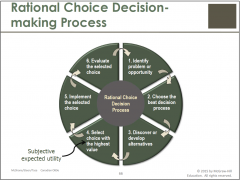
|
|
|
What is the main reason that a paradigm shift has happened in regards to the Rational Choice Decision Making Process?
|
In theory, the rational choice paradigm seems so logical, that it can be perceived as perfect. The truth is that in reality people are not and cannot be rational at all times. Because of this, theories and paradigms have been developed to understand why people cannot conduct decision making in a completely rational basis. |
|
|
What is meant by the term “Bounded Rationality”?
|
Bounded Rationality refers to a situation where decision makers have limited information, limited information processing capabilities, and tend toward satisficing (choosing a solution that is “good enough” rather than maximization of outcomes when making decisions to the highest utility.)
|
|
|
What are the five most common problem identification bias?
|
1. Stakeholder framing 2. Decisive leadership 3. Solution-focused problems 4. Perceptual defense 5. Mental models |
|
|
Explain Stakeholder Framing.
|
Stakeholders don’t always have interests and viewpoints that align. Sometimes what is good for one stakeholder is bad for another. Identifying a problem can be hard when there are so many conflicting stakeholder viewpoints presented.
|
|
|
Explain Decisive Leadership.
|
With leaders being evaluated on decisiveness - the ability to make decisionsquickly and effectively - many leaders are quick to identify problems and solutions without fully assessing the situation logically.
|
|
|
Explain Solution-Focused Problems.
|
Some businesses face difficulties due to the fact that decision makers are so focused to finding a solution to increasing operations/revenues, thatthey think of solutions first before taking the time to adequately address what the actual problem(s) may be.
|
|
|
Explain Perceptual Defense.
|
Sometimes people fail to become aware of a problem because they automatically blockout any bad news as a coping mechanism.
|
|
|
Explain Mental Models.
|
Mental models are visual or relational images in our mind of the external world.
|
|
|
What is meant by the term Heuristic?
|
Heuristics are mental shortcuts or rules of thumb. When we use heuristics, we use past experiences to make quick decisions. The advantage of heuristics is their speed, but the downside is that they may result in inaccurate decisions.
|
|
|
Describe the three most studied decision making heuristics within the field of OrganizationalBehaviour? |
1. The Anchoring and Adjustment Bias 2. The Availability Bias 3. The Representativeness Bias. |
|
|
Anchoring and Adjustment Bias
|
is a mental shortcut that involves using a number or value as a starting point, and then adjusting one's answer away from this anchor; people often do not adjust their answer sufficiently. People who have to make judgements under uncertainty use this heuristic by starting with a certain reference point (anchor) and then adjust it insufficiently to reach a final conclusion. Example: If you have to judge another person´s knowledge, the anchor for your final (adjusted) judgement may be your own level of knowledge. Depending on your own level of knowledge you might therefore underestimate or overestimate the knowledge of this person.
|
|
|
Availability Heuristic
|
is a mental shortcut that relies on immediate examples that come to a given person's mind when evaluating a specific topic, concept, method or decision. People tend to heavily weigh their judgments toward more recent information, making new opinions biased toward that latest news.
|
|
|
Representativeness Heuristic
|
We estimate the likelihood of an event by comparing it to an existing prototype that already exists in our minds. Our prototype is what we think is the most relevant or typical example of a particular event or object.
|
|
|
What is meant by the term “Satisficing”?
|
Satisficing is a term used to describe a scenario where an alternative that is “good enough” is selected rather than exploring alternative solutions which may result higher value (maximization).
|
|
|
What is meant by the term “intuition”?
|
refers to the ability to understand something immediately without the need for conscious reasoning.
|
|
|
What are three steps to assist one with making choicesmore effectively?
|
1. Systematically evaluate alternatives against relevant factors 2. Be aware of effects of emotions on decisionpreferences and evaluation process 3. Scenario planning |
|
|
Can anyone describe what “escalation of commitment” means?
|
The tendency to repeat an apparently bad decision or allocate more resources to a failing course of action.
|
|
|
4 Primary Reasons why decision makers get sucked into a stage of escalation of commitment.
|
1. self-justification effect 2. self-enhancement effect 3. prospect theory effect 4. sunk costs effect |
|
|
Self-Justification Effect
|
People engage in behaviours that convey a positive publicimage of themselves. In decision making, this self-justification typically involves appearing to be rational and competent. People are therefore motivated to demonstrate that their decisions will be successful, and this includes continuing to support those decisions even when there is evidence that they are not having the desired outcomes.
|
|
|
Self-Enhancement Effect
|
Some decision makers get emotionally involved with their projects. They see the success of their projects as a reflection of themselves and if the project fails, they see themselves as a failure. Because of this, some decision makers are resistant to evaluating the effectiveness of their solution because in doing so, it would have an impact on their self esteem, so they continue to support an unsuccessful solution until intervened.
|
|
|
Prospect Theory Effect
|
Some individuals undergo a significant negative and emotional experience if they are losing/wrong. The prospect theory takes place where a person is so wrapped up in “winning” that they will win at all costs (and typically go over budget with the results not being a guaranteed success).
|
|
|
Sunk Costs Effect
|
Another obstacle to axing a failing project is sunk cost - the value of resources already invested in the decision.
|
|
|
What are four steps to assist one with evaluating decisions better?
|
1. Separate decision choosers from evaluators 2. Establish a preset level to abandon the project 3. Find sources of systematic and clear feedback 4. Involve several people in the evaluation process |
|
|
List and describe each stage of the creativeprocess.
|
1. Preparation:• Develop a clear understanding of what you are trying to solve.• Gather and research relevant information. 2. Incubation:• A period of reflective thought.• We put the problem aside but are still thinking about it in thebackground. 3. Illumination (also called insight):• This is when we start to be come aware of unique ideas.• Starts with “Fringe Awareness” where the idea is visually depictedlike a light bulb and needs to be documented before lost. 4. Verification:• Final stage of the creative process.• This is where we take the ideas from stage 3 (illumination) anddraw detailed plans or experiment to see if it is viable. |
|
|
What is meant by the term “Divergent Thinking”?
|
Divergent Thinking is the process where one is able to reframe a problem in a unique way and thus generate different approaches to the issue.
|
|
|
Examples of Divergent Thinking
|
Brainstorming Mind mapping Free writing Keeping a Journal |
|
|
What are the typical characteristics of creative people?
|
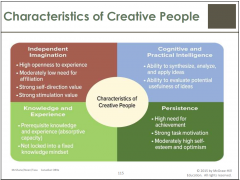
|
|
|
How can employers improve creativity?
|
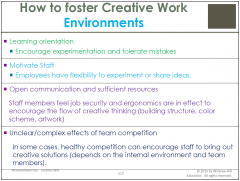
|
|
|
Activities that encourage creativity
|

|
|
|
List and explain the 4 stages of employeeinvolvement?
|
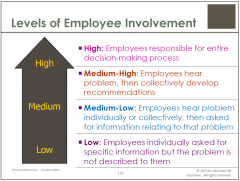
|
|
|
Under what circumstances is involving employees indecision making beneficial?
|
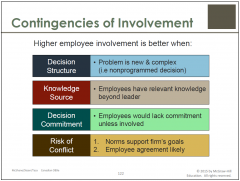
|

